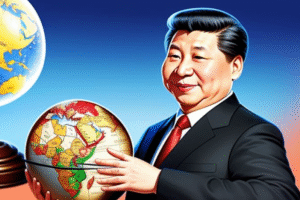$SPX $DIA #StockMarket #ChinaTrade #EconomicNews #Investing #Finance #MarketTrends #GlobalEconomy #WallStreet #InvestSmart
Why Are Stocks Plunging? The Impact of Rising China Trade Tensions Explained!
In the latest stocks news, major U.S. indices experienced significant declines as concerns over escalating trade tensions with China weighed heavily on investor sentiment. On Friday, the S&P 500 Index ($SPX) closed down 2.71%, while the Dow Jones Industrials Index ($DOWI) fell by 1.90%. The Nasdaq 100 Index ($IUXX) suffered the largest drop, ending the day down 3.49%. These declines reflect a growing unease among traders regarding the potential implications of strained relations with one of the world’s largest economies.
The backdrop of this market turmoil is the ongoing friction between the United States and China, characterized by tariffs and trade restrictions. As both nations engage in a tit-for-tat strategy, market participants are increasingly concerned about the potential for a prolonged economic downturn. Consequently, December E-mini S&P futures (ESZ25) fell by 2.61%, and December E-mini Nasdaq futures mirrored this downward trend, underscoring the pervasive anxiety throughout the market.
Investors are closely monitoring announcements from both governments, as any escalation could lead to further market instability. The uncertainty surrounding trade negotiations has created a ripple effect across various sectors, with technology and manufacturing particularly vulnerable. These industries are heavily reliant on global supply chains and could face significant disruptions if tensions escalate further.
The Broader Economic Implications
The ramifications of these trade tensions extend beyond immediate stock market reactions. Economists warn that prolonged uncertainty could dampen consumer confidence, leading to reduced spending and investment. As history has shown, economic slowdowns often precede market corrections, and investors are becoming increasingly cautious as they navigate these turbulent waters.
Moreover, analysts are keeping a close watch on key economic indicators that could signal a shift in market dynamics. For instance, employment figures and consumer spending reports will be critical in assessing the resilience of the U.S. economy in the face of global challenges. If these indicators show signs of weakness, the stock market could face additional pressure, exacerbating the current decline.
As we look ahead, investors must remain vigilant and consider diversifying their portfolios to mitigate risks associated with geopolitical developments. Strategies that include a mix of equities, fixed income, and alternative investments may provide a buffer against market volatility.
What Lies Ahead for Investors?
Given the current climate, investors should be prepared for continued fluctuations in stock prices. It is essential to stay informed about developments in trade relations and the broader economic landscape. Engaging with reliable financial news sources and analysis will be crucial to making informed investment decisions.
Furthermore, for those interested in exploring new opportunities, consider looking into sectors that may benefit from a shift in consumer behavior or government policies. The energy and health care sectors, for example, have shown resilience in past downturns and could offer potential for growth.
In conclusion, while the immediate outlook appears challenging, savvy investors can leverage this environment to their advantage. By staying informed and adaptable, they can navigate the complexities of the market during these uncertain times. For more insights on stock market trends, visit our dedicated stock news section.











Comments are closed.